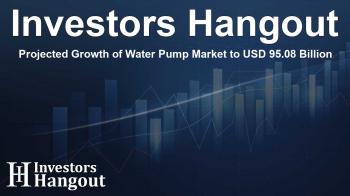Projected Growth of Water Pump Market to USD 95.08 Billion

Projected Growth in the Water Pump Market
The water pump market is expected to experience remarkable growth in the coming years, with projections estimating its value to reach USD 95.08 billion by 2032. This increase represents a far-reaching annual growth rate of 4.36% from a valuation of USD 67.85 billion in 2024. Key drivers behind this surge include rising investments in urban water infrastructure and the ever-expanding adoption of intelligent agricultural practices.
Market Drivers Shaping Growth
The growing demand for efficient water management solutions amidst global water scarcity concerns has put pressure on industries such as agriculture, residential sectors, and manufacturing. Water pumps are becoming essential tools for quickly and reliably moving water, whether for irrigation in agriculture or for operational needs in various industrial processes.
Understanding Regional Trends
When observing the regional landscape, the U.S. water pump market—estimated at USD 21.67 billion in 2024—is projected to reach approximately USD 19.99 billion by 2032, with a compound annual growth rate (CAGR) of 5.59% during the forecast period. This suggests robust activity and investment in water systems, driven in large part by infrastructure modernization.
Key Players Energizing Competition
The competitive landscape is characterized by key players such as KSB SE & Co. KGaA, Flowserve, and ITT Inc., among others. These companies are at the forefront of technological innovation, striving to provide high-efficiency solutions that meet the demands of modern infrastructure and smart agriculture.
Market Segmentation Analysis
Delving into market segmentation reveals that centrifugal pumps dominate the water pump market, accounting for a revenue share of approximately 65.22% in 2024. Their design simplicity and efficiency make them suitable for a myriad of applications from municipal water supply to industrial processes. In fact, as agricultural systems evolve, the automation of irrigation using these pumps becomes increasingly vital.
Segmental Dominance: Business and Channel Insights
Business Segment Overview
The business segment, contributing to 59% of the total revenue in 2024, highlights the broad utilization of water pumps across various sectors, including agriculture and utilities. The impetus towards smart cities and water efficiency is driving upgrades, emphasizing low-maintenance and energy-efficient pumping solutions.
Distribution Channel Dynamics
Direct sales are emerging as the leading distribution channel, allowing manufacturers to exercise greater control over pricing, customer engagement, and product customization. This is a particularly advantageous channel for addressing the specific challenges faced by industries like agriculture and municipal projects.
Innovations in Agricultural Pump Solutions
The agricultural sector remains a major focus, driven by the need for water-efficient irrigation methods. An increase in government support for modern farming practices enhances the demand for sophisticated pumps, including electric and solar-powered models. These innovations are crucial in the face of climate variability, which intensifies the need for reliable water sources.
Navigating North America's Water Challenges
In North America, a steady CAGR of approximately 5.95% underscores the region's established infrastructure dedicated to water conservation. This growth is further fueled by federal support aimed at improving rural water systems and promoting irrigation efficiency. The replacement of aging infrastructure, combined with the demand for energy-efficient pump solutions, positions North America for continued expansion in this vital market.
Conclusion: Looking Ahead
The water pump market stands on the precipice of significant transformation, driven by infrastructure needs and sustainability goals, reflecting a global shift in focus towards more efficient water management. As industry players innovate and adapt to emerging demands, the market promises a robust future. Continuous research and adaptation to changing conditions will be key for stakeholders aiming to capitalize on this growing sector.
Frequently Asked Questions
What is the expected size of the water pump market by 2032?
The water pump market is projected to reach USD 95.08 billion by 2032.
What factors drive the growth of the water pump market?
Key factors include rising infrastructure investments and the adoption of smart agriculture practices.
Which segment dominates the water pump market?
Centrifugal pumps hold the largest share of the water pump market, accounting for about 65.22% of revenue in 2024.
How does the North American market benefit from recent trends?
The North American market benefits from established infrastructure and federal support aimed at water conservation and efficiency.
What role do key players like Flowserve play in the market?
Key players like Flowserve lead in technological innovation and efficient water management solutions.
About The Author
Contact Dylan Bailey privately here. Or send an email with ATTN: Dylan Bailey as the subject to contact@investorshangout.com.
About Investors Hangout
Investors Hangout is a leading online stock forum for financial discussion and learning, offering a wide range of free tools and resources. It draws in traders of all levels, who exchange market knowledge, investigate trading tactics, and keep an eye on industry developments in real time. Featuring financial articles, stock message boards, quotes, charts, company profiles, and live news updates. Through cooperative learning and a wealth of informational resources, it helps users from novices creating their first portfolios to experts honing their techniques. Join Investors Hangout today: https://investorshangout.com/
The content of this article is based on factual, publicly available information and does not represent legal, financial, or investment advice. Investors Hangout does not offer financial advice, and the author is not a licensed financial advisor. Consult a qualified advisor before making any financial or investment decisions based on this article. This article should not be considered advice to purchase, sell, or hold any securities or other investments. If any of the material provided here is inaccurate, please contact us for corrections.

